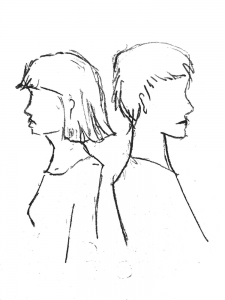COLUMN: Media must engage young men
Undoubtedly, there has been a certain rise in consciousness about gender efforts within the last decade. Feminism and LGBTQ issues — although frequently co-opted in a problematic fashion — have at the very least entered mainstream discourse. Although growing in ubiquity, content that engages issues of equality is almost exclusively marketed toward young women and girls. An obvious contradiction then appears. How can a society effectively address inequality if only half the population receives the message? Both men and boys are essential partners to challenging gender roles and promoting equality.
The dearth of empowering content marketed toward men and boys appears to be the product of internalized false narratives. The wage gap and violence against women, for example, are framed as “women’s issues.” The wage gap is not merely a women’s issue when the average woman makes only 80 cents for every dollar men — the gatekeepers of privilege and power — earn. When women are the sole or co-breadwinner in more than half of American families, according to a December 2016 report by American Progress, and this unconscionable disparity affects not only women but also men and children.
Moreover, violence against women is not merely a women’s issue. It is, rather, primarily a men’s issue when men, with limited exceptions, are the sole perpetrators of violence against women. Narratives promoting a kind of toxic masculinity that values dominating women and devalues the expression of emotion and sensitivity not only embolden physical violence but also encourage violence that can be psychologically paralyzing for women and girls. Empowering content would dispose of false narratives and encourage both boys and men to choose empathy, rather than ego.
This shift in consciousness requires the cooperation of the media. For example, Teen Vogue is an example of a traditionally apolitical publication that has emerged as an influential voice on social and political issues.
Some of its stories from the past year include an interview examining what it means to be a Muslim woman in the Trump era and a list of reasons why Vice President Mike Pence’s record on reproductive and LGBTQ rights should give readers pause. Marketed exclusively toward teenage girls, Teen Vogue reaches its demographic at a formative point in its readers’ lives.
Where are the socially and politically conscious publications with young male readerships? Unfortunately, they are nowhere to be found. In their absence, young men and boys are left to consume stray copies of GQ, which is rife with hypersexualized images of women. Given the rise of digital media, reductive images of Kate Upton enjoying a popsicle in a bikini or a pop star in her underwear carrying a football helmet are just a few clicks away.
Men and boys will only become the effective partners needed when the media decides to challenge the norms it has promulgated and puts an end to the epistemic violence that has resulted. With 92 percent of teens reportedly going online daily according to the Pew Research Center, this campaign must begin on smartphones and computer screens.
Social media is the one of the easiest ways to promote and combat harmful stereotypes. Given the power to share, we have essentially become part of the “media,” crafting our own stories on our timelines. While we press traditional media to publish empowering content marketed toward both boys and men, we have a responsibility to be mindful of the content we share. The current political climate, as rooms full of men wield unimaginable influence over millions of lives, indeed demands that we ask more of the sources we consume and of ourselves.
Bailee Ahern is a senior majoring in political science and international relations. Her column, “Vis-à-Vis,” runs every other Monday.

